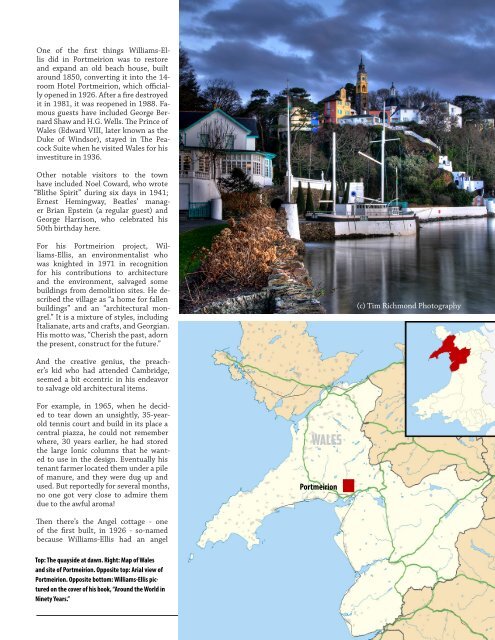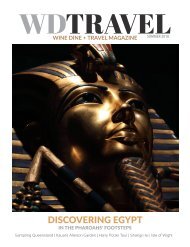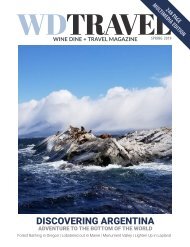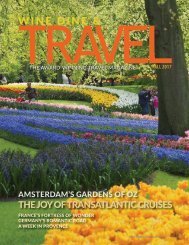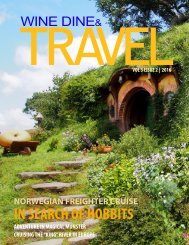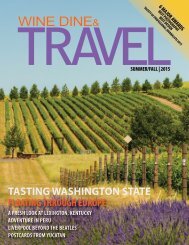WINE DINE & TRAVEL MAGAZINE SPRING 2015
Enjoy the many adventures packed into this issue with its stories that cover the globe, from Asia to Palm Springs. Take a hike around Lake Lucerne, explore the glories of Whidbey Island, cruise exotic Southeast Asia and take an African safari. Wine lovers also have a treat with Ron James' tongue-in-cheek wine enthusiast’s guide and a primer on rose wine by our resident wine expert Robert Whitley.
Enjoy the many adventures packed into this issue with its stories that cover the globe, from Asia to Palm Springs. Take a hike around Lake Lucerne, explore the glories of Whidbey Island, cruise exotic Southeast Asia and take an African safari. Wine lovers also have a treat with Ron James' tongue-in-cheek wine enthusiast’s guide and a primer on rose wine by our resident wine expert Robert Whitley.
Create successful ePaper yourself
Turn your PDF publications into a flip-book with our unique Google optimized e-Paper software.
One of the first things Williams-Ellis<br />
did in Portmeirion was to restore<br />
and expand an old beach house, built<br />
around 1850, converting it into the 14-<br />
room Hotel Portmeirion, which officially<br />
opened in 1926. After a fire destroyed<br />
it in 1981, it was reopened in 1988. Famous<br />
guests have included George Bernard<br />
Shaw and H.G. Wells. The Prince of<br />
Wales (Edward VIII, later known as the<br />
Duke of Windsor), stayed in The Peacock<br />
Suite when he visited Wales for his<br />
investiture in 1936.<br />
Other notable visitors to the town<br />
have included Noel Coward, who wrote<br />
“Blithe Spirit” during six days in 1941;<br />
Ernest Hemingway, Beatles’ manager<br />
Brian Epstein (a regular guest) and<br />
George Harrison, who celebrated his<br />
50th birthday here.<br />
For his Portmeirion project, Williams-Ellis,<br />
an environmentalist who<br />
was knighted in 1971 in recognition<br />
for his contributions to architecture<br />
and the environment, salvaged some<br />
buildings from demolition sites. He described<br />
the village as “a home for fallen<br />
buildings” and an “architectural mongrel.”<br />
It is a mixture of styles, including<br />
Italianate, arts and crafts, and Georgian.<br />
His motto was, “Cherish the past, adorn<br />
the present, construct for the future.”<br />
(c) Tim Richmond Photography<br />
And the creative genius, the preacher’s<br />
kid who had attended Cambridge,<br />
seemed a bit eccentric in his endeavor<br />
to salvage old architectural items.<br />
For example, in 1965, when he decided<br />
to tear down an unsightly, 35-yearold<br />
tennis court and build in its place a<br />
central piazza, he could not remember<br />
where, 30 years earlier, he had stored<br />
the large Ionic columns that he wanted<br />
to use in the design. Eventually his<br />
tenant farmer located them under a pile<br />
of manure, and they were dug up and<br />
used. But reportedly for several months,<br />
no one got very close to admire them<br />
due to the awful aroma!<br />
WALES<br />
Portmeirion<br />
Then there’s the Angel cottage - one<br />
of the first built, in 1926 - so-named<br />
because Williams-Ellis had an angel<br />
Top: The quayside at dawn. Right: Map of Wales<br />
and site of Portmeirion. Opposite top: Arial view of<br />
Portmeirion. Opposite bottom: Williams-Ellis pictured<br />
on the cover of his book, “Around the World in<br />
Ninety Years.”<br />
Wine Dine & Travel Winter <strong>2015</strong> 53


